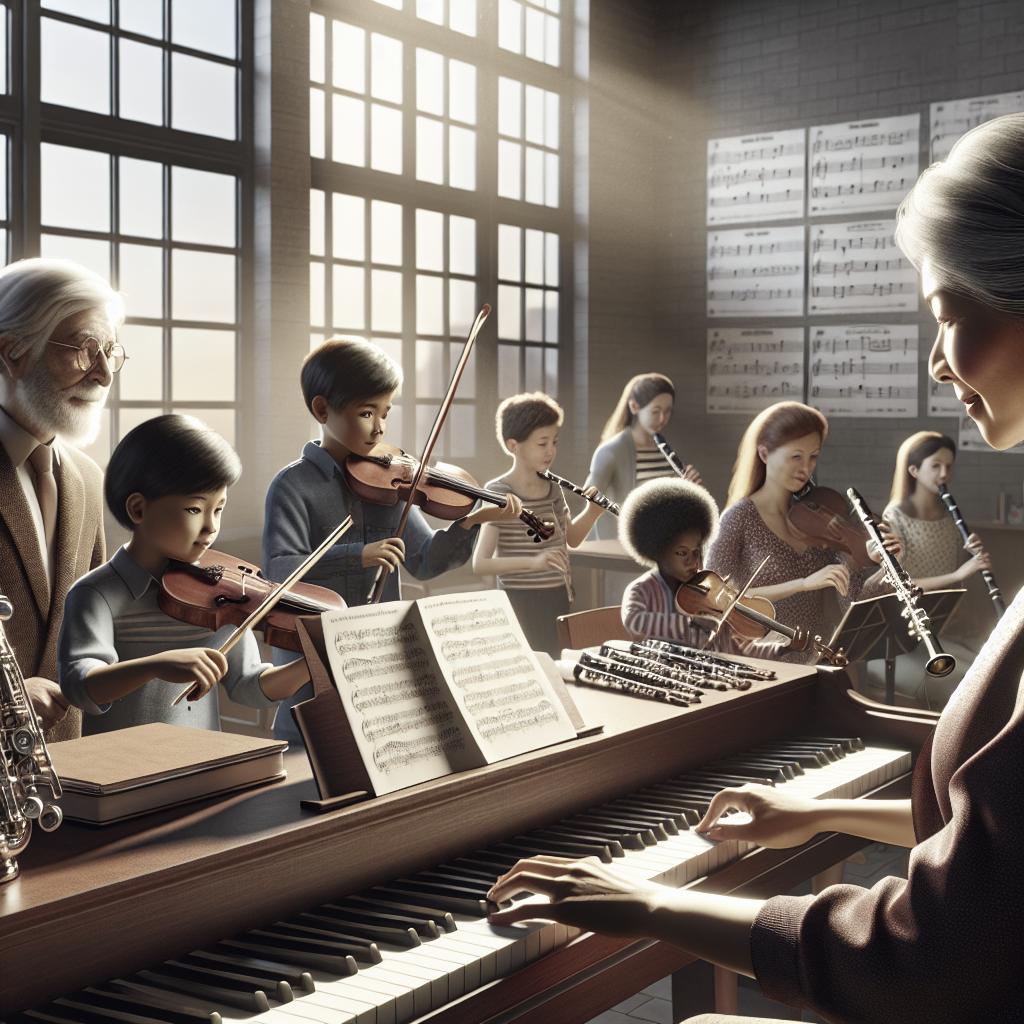How to Teach Music to Beginners Effectively
Teaching music to beginners is both a challenging and rewarding journey. This process involves understanding the unique ways in which different individuals learn, breaking down the complexities of songs into digestible parts, and employing diverse techniques to make learning enjoyable and effective. To provide a comprehensive guide, this article delves into various teaching methods, from the Breakdown Method to determining your learning style—Visual, Auditory, or Tactile. Additionally, it offers insights into selecting the right song and tips on how to conclude learning on a positive note. Whether you are teaching singing online or in a classroom, these strategies will equip you with the tools to nurture budding musicians and inspire a lifelong passion for music.
Leave a comment
Teaching music to beginners often sparks numerous questions and insights from both learners and instructors. As you engage with this article, we invite you to leave a comment sharing your experiences and questions. Your contributions can provide valuable feedback and spark lively discussions that enrich the learning process for everyone involved.
Whether you’re a seasoned music teacher or a beginner just starting their musical journey, each perspective adds depth to our collective understanding. Let’s create a collaborative space by exchanging ideas and techniques, which might just help someone else overcome a challenge or find that next step in their learning journey.
The Breakdown Method of Learning a Song
The Breakdown Method is all about simplifying a song into manageable pieces, making it easier for beginners to grasp and enjoy the learning process. This involves dissecting the song into its core components, such as melody, rhythm, and lyrics, then teaching each part before bringing them together into one cohesive performance. With patience and practice, learners can gradually build confidence and proficiency.
To apply this method effectively, start with the melody, focusing on the pitch and flow, before moving onto the rhythm, where learners can clap or tap to internalize the beat. Finally, work through the lyrics, encouraging learners to understand their meaning and emotional nuance, which adds depth to the performance. A methodical yet flexible approach ensures no component is overlooked, inspiring a comprehensive understanding of the song.
A Geeky Voice Teacher’s Advice to Learning Songs
Many expert music teachers agree that a geeky, detail-oriented perspective can significantly enhance how beginners learn songs. This approach encourages a deep dive into technicalities like breath control, diction, pitch accuracy, and emotional expression. By breaking down these elements, instructors can provide tailored advice to help learners refine their skills and appreciate the intricacies of music.
One key piece of advice is to cultivate a curious mindset. Encourage learners to explore the historical background of the song, the artist’s intent, and the cultural context. Such an analytical approach not only enriches the learning experience but also inspires learners to connect more profoundly with the music they are practicing.
I Teach Singing Online
Online singing lessons have become an effective avenue for teaching music to beginners, offering flexibility and accessibility. As an online music instructor, it’s crucial to create an engaging virtual environment that mimics the efficacy of in-person teaching. Leverage technology to provide resources like tutorials, practice exercises, and one-on-one feedback sessions.
Using interactive tools, such as digital sheet music and recording software, can help learners track their progress and overcome obstacles. With effective communication and ongoing encouragement, online lessons can be tailored to suit individual learning styles, ensuring that each student experiences a personalized path to musical mastery.
How to Determine What Kind of “Song Learner” You Are
Understanding your learning style is vital to mastering music efficiently. It’s important to identify whether you are a visual, auditory, or tactile learner, as this affects how you perceive and process musical information. Tailoring your study approach to your dominant learning style can make the difference between a challenging struggle and a smooth, enjoyable learning experience.
Take a moment to reflect on past learning experiences or try experimenting with different methods to determine your dominant style. Once identified, you can adapt your practice sessions to best fit your natural approach to learning, thus maximizing your progression and confidence in music.
Visual Song Learners
Visual learners thrive when they can see and visualize information. They benefit from sheet music, charts, and diagrams, as these materials allow them to picture the progression of a song. Videos and live performances also serve as valuable resources, providing clear models to emulate when learning a new piece.
For visual learners, consider using color-coding to highlight different song sections or dynamics in the sheet music. Practice reading music or watching videos while following along with the lyrics to strengthen visual connections and improve memory retention of the song.
Auditory Song Learners
Auditory learners excel when they can hear the music. They often rely on listening to recordings repetitively to internalize melodies and rhythms, making audio resources such as streaming platforms or music apps crucial in their learning process. Listening to different interpretations of a song can also offer new insights and inspire creativity.
Encourage auditory learners to record their practice sessions and play them back. This self-auditory feedback helps identify areas of improvement and develops an acute awareness of pitch and timing, critical components in building musical skills.
Tactile Song Learners
Tactile learners learn best through physical engagement with music. They often benefit from playing instruments, tapping rhythms, or using hand movements to memorize songs. These learners thrive on a hands-on approach that allows them to physically explore music concepts.
To support tactile learners, incorporate physical activities into lessons. Tasks such as drumming patterns, clapping rhythms, or playing scales can reinforce music concepts by combining movement and sound, making learning more immersive and memorable.
The Formula for Learning and Memorizing Songs
The most successful musicians use structured formulas to learn and memorize songs effectively. This approach emphasizes repetition and gradual mastery of song components, combined into a structured practice routine. This includes starting slow, repetition, and increasing complexity over time to challenge and build skills.
Set aside regular practice intervals focusing on specific song sections, gradually integrating these parts into the full arrangement. Pay attention to problem areas during each session and use focused exercises to overcome these obstacles, enhancing memory retention and confidence in performance.
For a More Thorough Finish: Learn the Connections
Beyond mastering the technical aspects, it’s crucial to comprehend the connections within a song. Understanding these links involves recognizing how lyrical themes relate to melody and rhythm, offering a deeper insight into the piece’s character and story.
Encourage learners to explore variations and alternate renditions of the song, which can reveal new connections and interpretations. This newfound depth of understanding not only assists with memorization but also enriches personal and creative expression in performance.
What’s YOUR Method of Learning a Song?
Encouraging self-awareness about personal learning methods is key to effective music education. Each beginner should reflect on their practice styles and outcomes, identifying what techniques yield the best results. Customizing a personal approach ensures that learning remains enjoyable and fruitful, tailored to individual preferences and strengths.
Invite learners to share their methods within a community of peers, exchanging tips and insights that may benefit others. Collaborating with fellow musicians fosters a supportive learning environment, providing new perspectives and inspiration that can enhance the learning journey.
How to Choose a Song to Learn?
Choosing the right song is fundamental to maintaining engagement and motivation in beginners. Consider songs that are both challenging and enjoyable, stimulating interest and nurturing progress. Select pieces that align with personal musical interests or themes that resonate emotionally.
Guiding beginners in this choice involves balancing difficulty with achievable goals. Gradual increments in complexity ensure that learners continue to develop their skills without becoming overwhelmed. Emphasize the importance of enjoying the music, making practice both fun and rewarding.
Last Tip – Finish on a High
It’s essential to conclude each learning session on a positive note. Encouragement and acknowledgment of progress, no matter how small, boost confidence and motivation. Celebrate achievements by recording milestones and performances, allowing learners to see and appreciate their growth over time.
Create a consistent end-of-session routine that leaves learners feeling accomplished and eager to return. This approach ensures that music becomes a consistent and uplifting presence in their lives, sustaining their passion for the art long-term.
Take Your Desire to Sing Seriously: Get Tools to Become a Better Singer in Your Inbox
Continuous learning is a vital aspect of mastering music, and the tools to improve are readily accessible. Subscribing to online newsletters, tutorials, and resources ensures that you remain informed about techniques and trends. These tools provide guidance and inspiration, enriching your musical journey with fresh ideas.
Invest in your passion by seeking regular updates and education. Staying connected with a community of learners and educators through digital platforms fosters an environment of growth and support, empowering you to take your musical abilities to new heights.
Next Steps
| Section | Summary |
|---|---|
| Leave a Comment | Encourages sharing experiences and questions to enhance learning. |
| The Breakdown Method | Describes breaking down songs into melody, rhythm, and lyrics for easier learning. |
| A Geeky Voice Teacher’s Advice | Stresses learning technical details for a deeper understanding of songs. |
| I Teach Singing Online | Discusses the effectiveness of online singing lessons and leveraging technology. |
| What Kind of “Song Learner” You Are | Emphasizes identifying learning styles: Visual, Auditory, Tactile. |
| Learning and Memorizing Songs | Suggests structured formulas and understanding song connections. |
| What’s YOUR Method? | Encourages self-awareness and sharing personal learning methods. |
| How to Choose a Song? | Guides on selecting songs for engagement and development. |
| Last Tip – Finish on a High | Highlights ending sessions positively to boost motivation. |
| Get Tools to Become a Better Singer | Encourages continuous learning via online resources. |


